#Dorothea Graff
Explore tagged Tumblr posts
Text

Between encyclopedia and fairy tale – the wondrous birds and reptiles of 18th-century artist Dorothea Graff.
72 notes
·
View notes
Text
Maria Sibylla Merian was born #OTD (German, 2 Apr 1647 – 13 Jan 1717).
Here are a few of her works that were recently on display at the “Making Her Mark: A History of Women Art in Europe, 1400-1800” exhibition at Baltimore Museum of Art :
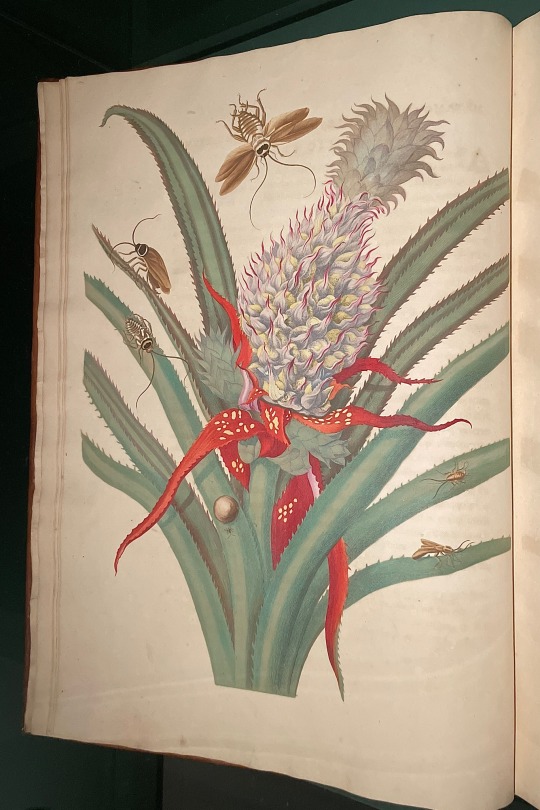

1. “Pineapple with Cockroaches” in Dissertatio de Generatione et Metamorphosibus Insectorum Surinamensium... (Dissertation on the generations and metamorphosis of Surinamese insects), 1719
Bound volume of hand-colored engravings and etchings
“This ripening pineapple's sweet aroma attracts a swarm of cockroaches. Maria Sibylla Merian observed this interaction during a three-year, self-financed voyage with her daughter Dorothea Maria to the South American country of Suriname, then a Dutch colony, in 1699. While there, Merian studied the native plant and insect life, learning their uses and behavior from enslaved African and Indigenous guides working at the sugar plantation where she stayed. In her notes, Merian characterized the pineapple as "the most outstanding of all edible fruits" and cockroaches as "the most infamous of all insects in America."
Merian's illustrations innovatively presented insect life cycles, habitats, and the broader ecological dynamic. After returning to the Netherlands, Merian published an illustrated compilation, creating one of the most important natural history publications of the time.
Her daughters Dorothea Maria Graff and Johanna Helena Herolt-Graff continued to issue editions after Merian's death, such as this deluxe version, contributing to their mother's foundational reputation in entomology.”

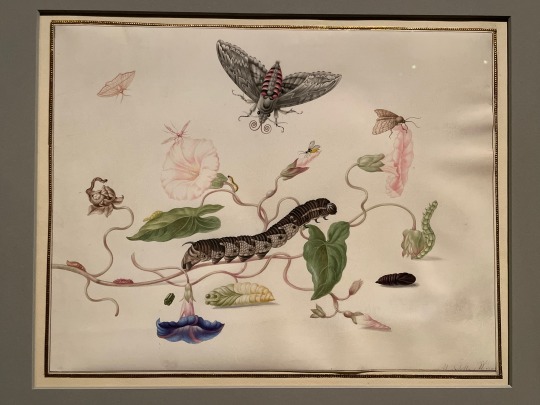
2. Frontispiece of Der Raupen wunderbare Verwandelung und sonderbare Blumen-Nahrung (The Wondrous Transformation of Caterpillars and their Curious Diet of Flowers), 1679-83
Bound volume w/ hand colored engraved illustrations
3. Convolvulus and Metamorphosis of the Convolvulus Hawk Moth, c.1670-1683
Watercolor w/ touches of opaque watercolor over indications in black chalk or graphite on vellum
“Maria Sibylla Merian had a close relationship with caterpillars, rearing them from egg to adult in her home over a decade. This engaging illustration of the life cycle of the convolvulus hawk moth on the wall above is the result of her sustained observations and her exceptional artistic talent. Creating an intertwined vignette of insect and plant life, Merian constructed a life cycle image that became a standard in scientific illustration and shaped the field of entomology. Her findings and illustrations contributed to a foundational reference text on insect metamorphosis, Der Raupen wunderbare Verwandlung und sonderbare Blumen-Nahrung, on display here.”
#animals in art#european art#museum visit#exhibition#Baltimore Museum of Art#Maria Sibylla Merian#women artists#women in science#women in STEM#book plate#frontispiece#watercolor#scientific illustration#natural history art#entomology#botany#caterpillars#butterflies#moths#lepidoptera#17th century art#metamorphosis#colonial art
13 notes
·
View notes
Photo

Tarantulas by Dorothea Graff
4 notes
·
View notes
Text

Dorothea Eliza Smith “Fruits of the Lima Market” watercolors collection 1850-53

Johanna Helena Herolt Graff “Still life with fruit and Blue-Backed Manakin“ c.1705

Maria Sibylla Merian “Ornate Lory on a branch of Peach‘ c.1705 Royal Collection Trust
45 notes
·
View notes
Photo

Metamorphosis of a Small Emperor Moth, Maria Sibylla Merian’s workshop, attributed to Dorothea Maria Graff, after 1679
RIJKS Amsterdam
Provenance: purchased in 1946 by the museum from the art dealer Bernard Houthakker
h 192 mm × w 155 mm
Dorothea Maria Graff (1678–1743) was an 18th-century painter from Germany, who lived and worked in Amsterdam, and Saint Petersburg. She was the daughter of naturalist Maria Sibylla Merian and the sister of Johanna Helena Herolt who was also a botanical artist. In 1691 they moved to Amsterdam, where they set up a studio painting flowers and botanical subjects. In 1713 Maria published a book on caterpillars (Der rupsen begin, voedsel en wonderbaare veranderingen), followed by the second volume in 1714. Though her daughters are not mentioned by name, both Johanna and Dorothea probably contributed to the plates.
[text source: @wikipedia]
#17th century#small emperor moth#maria sibylla merian#dorothea maria graff#manuscript painting#museum#public domain#global art history
29 notes
·
View notes
Photo

Art by Dorothea Maria Graff (1678–1743) was an 18th-century painter from Germany, who lived and worked in Amsterdam, and Saint Petersburg and lived for a while in Surinam.
9 notes
·
View notes
Photo

Two examples of snakes, one red and black, entwined around a pink-flowered plant, from an album entitled "Merian's Drawings of Surinam Insects &c" - attributed to Dorothea Graff, assigned to Maria Sibylla Merian - c.1710 - via The British Museum
159 notes
·
View notes
Photo

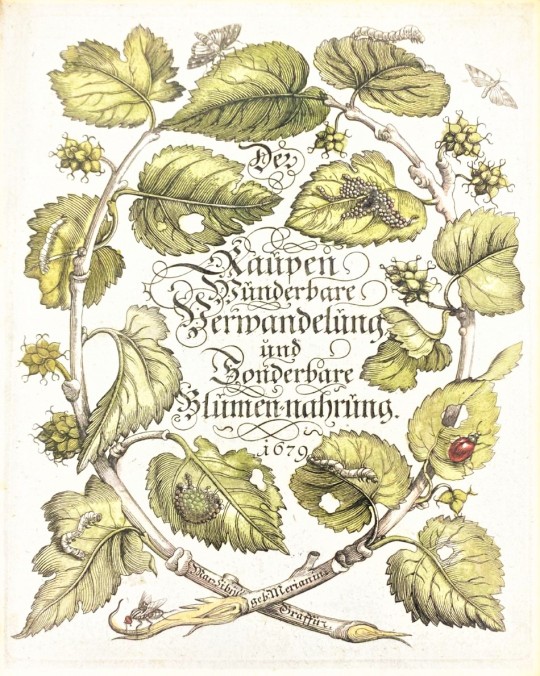

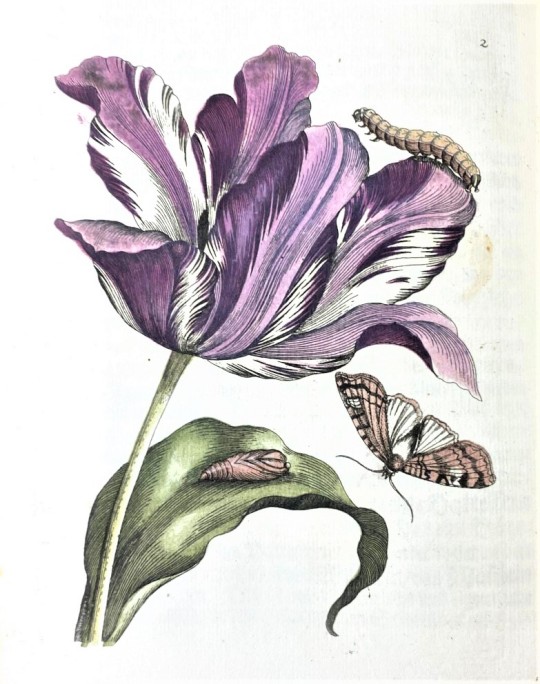
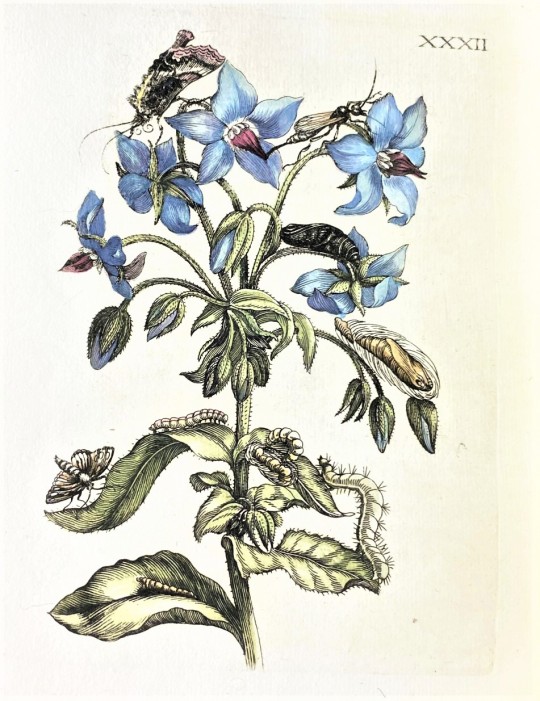
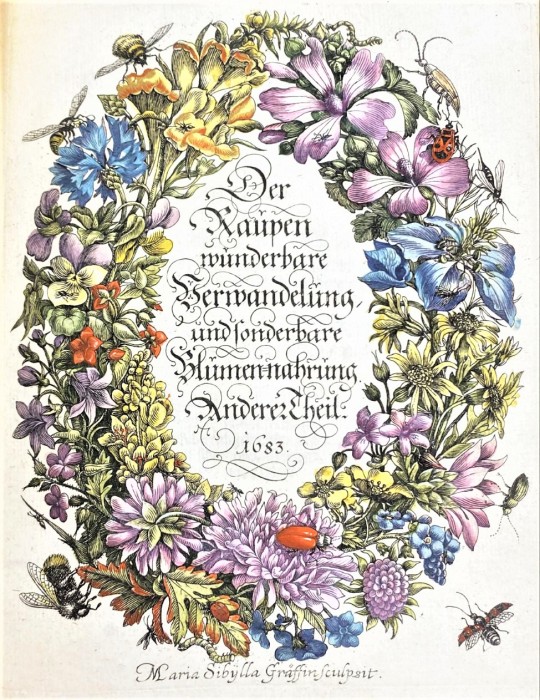
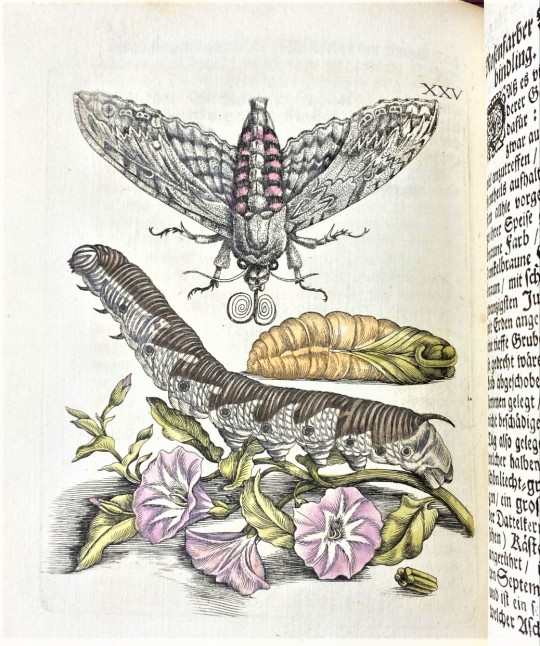
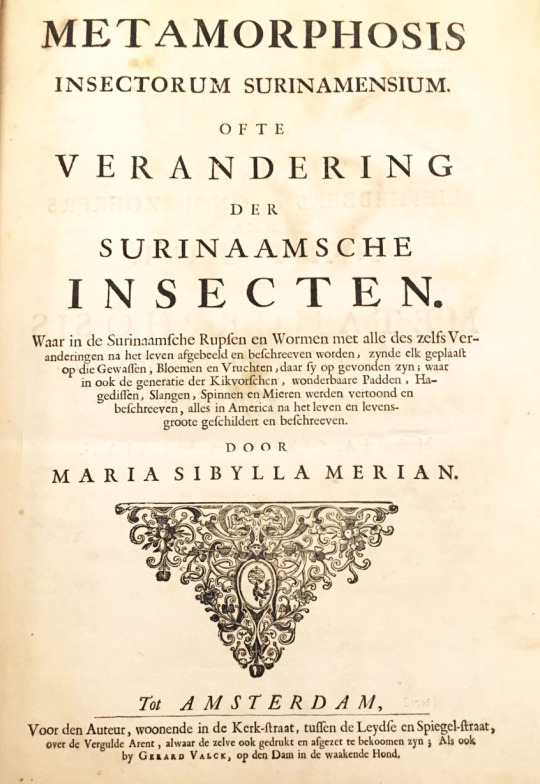
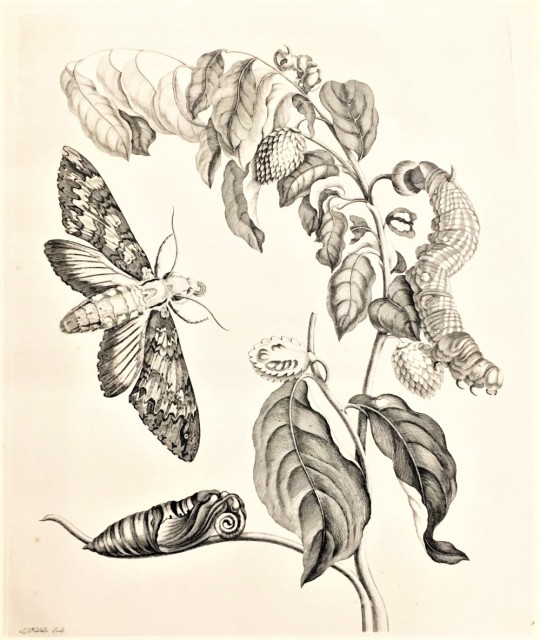
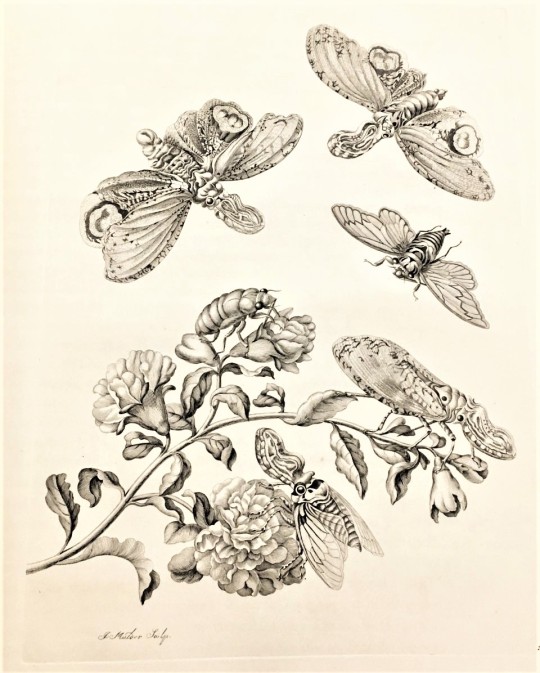
The Spectacle of Nature: Maria Sibylla Merian’s Insects
This week we are highlighting German-born naturalist and artist Maria Sibylla Merian (1647-1717) whose direct observations of insects led to new insights about metamorphosis. Merian was born in Frankfurt to an artistic family. Her father was Mathias Merian, a prominent publisher and artist who died in 1650 when Maria was 3 years old. A year later, Maria’s mother Johanna Sybilla Heyne remarried Jacob Marrel, a still life painter, who encouraged Maria’s artistic pursuits and taught her copperplate engraving alongside his male pupils. Throughout her life, Maria was fascinated by insects. She would study caterpillars and document their life cycles through drawings. When Maria was 18 years old, she married Johann Graffe, a former apprentice of her stepfather. They moved to Nuremberg and had two daughters, Johanna Helena and Dorothea Maria.
While in Nuremberg, Maria Sibylla Merian made money by selling watercolors and giving artistic lessons in embroidery and painting to wealthy young women. Between 1675 to 1680, she published her books of flowers Blumenbuch in three parts. They were meant to be pattern-design model books for embroidery. Merian published her first scientific book in two parts in 1679 and 1683, Der Raupen wunderbare Verwandlung und sonderbare Blumennahrung (“Caterpillars, Their Wondrous Transformation and Peculiar Nourishment from Flowers”), which served as an important precursor to her landmark work Metamorphosis.
In 1685, Merian left her marriage and entered the spiritual Labadist community in the Netherlands with her daughters and mother. While living with the Labadists, Merian continued to study plants, insects, and frogs. Eventually she withdrew from the community and moved to Amsterdam with her daughters and officially divorced her husband. In the progressive city of Amsterdam, Merian and her daughters were able to open their own studio and work as independent artists. Amsterdam was also the center of world trade at the time due to the endeavors of the Dutch East India Company, and there were numerous natural history cabinets in the city to study from.
In 1699, the 52-year-old Merian, accompanied by her daughter Dorothea, set off on a scientific expedition to the Dutch colony of Suriname in South America. Maria and Dorothea explored the rain forest and directly observed the stages of metamorphosis of insects. The trip only lasted two years because Merian contracted malaria and returned to Amsterdam in 1701 with Dorothea. The two women brought back a wealth of sketches, paintings, observational notes, and specimens.
In 1705, Maria Sibylla Merian published her groundbreaking work Metamorphosis insectorum Surinamensium. The book was issued in a folio edition of 60 copperplate engravings available in both black-and-white, and hand-colored by the author at extra cost. Merian depicted the metamorphosis of insects by depicting their life cycles and placing them on their food plants in a naturalistic way. Merian died in 1717, and four editions of Metamorphosis were published after her death.
Unfortunately we do not have any of Maria Sibylla Merian’s books here in UW-Milwaukee Special Collections. These images come from UW-Madison Special Collections copy of Der Raupen wunderbare Verwandelung und sonderbare Blumen-Nahrung. I also included images of Metamorphosis insectorum Surinamensium from USC Special Collections from my experience at California Rare Book School. The Maria Sibylla Merian Society has a great guide to online versions of Merian’s work.
View more posts in the “Spectacle of Nature” series.
–Sarah, Special Collections Senior Graduate Intern
#The Spectacle of Nature#Science Saturday#Maria Sibylla Merian#Metamorphosis insectorum Surinamensium#Der Raupen wunderbare Verwandelung und sonderbare Blumen-Nahrung#insects#scientific illustration#botanical illustrations#bugs#17h century#history of science#copperplate engravings#hand colored plates#UW-Madison Special Collections#Jacob Marrel#German#South America#metamorphosis#insect#natural history#biological illustration#biology#natural history illustration#Sarah Finn#sarah
350 notes
·
View notes
Text
Maria Sibylla Merian la donna che dipingeva gli insetti
https://www.unadonnalgiorno.it/maria-sibylla-merian/
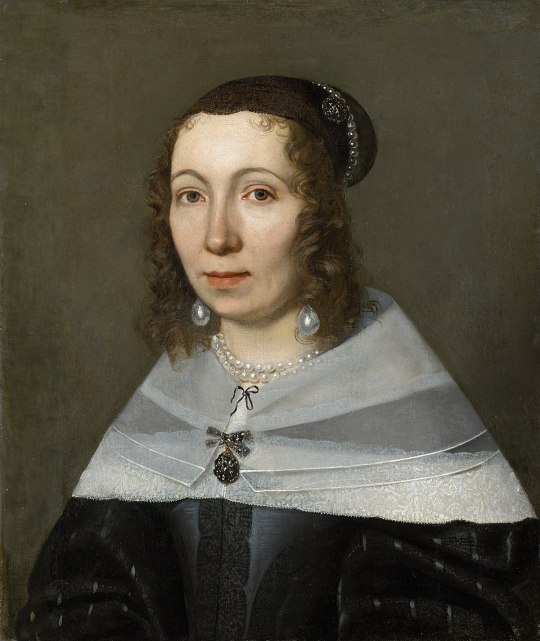
Maria Sibylla Merian, naturalista e pittrice tedesca, è stata una delle più grandi ricercatrici e disegnatrici di insetti e farfalle di tutti i tempi, in un’epoca in cui erano considerati le bestie di Satana e a nessuno veniva in mente di studiarli.
Una donna coraggiosa e determinata che ha vissuto per rincorrere la sua passione, nonostante vivesse in un mondo che non era ancora pronto alle sue scelte.
Nata a Francoforte sul Meno, il 2 aprile 1647 era figlia dell’incisore e editore svizzero Matthäus Merian il vecchio, morto quando lei aveva tre anni e di Johanna Sibylla Heim, che si era risposata con un pittore di fiori, Jakob Marell, che le insegnò il disegno, la pittura ad olio, l’acquerello e l’incisione. Aveva tredici anni quando cominciò a dipingere immagini d’insetti e di piante presi direttamente dalla natura.
A diciotto anni ha sposato un allievo del patrigno, Johann Andreas Graff, pittore specializzato in disegni prospettici di architetture con cui si trasferì a Norimberga.
Nonostante ai tempi si pensasse che gli insetti fossero il risultato di una generazione spontanea avvenuta dalla putrefazione e quindi considerati bestie diaboliche, Maria Sibylla Merian si appassionò alla loro trasformazione. Teneva i bruchi nel suo laboratorio, li nutriva, ne osservava i comportamenti e li disegnava in ogni periodo del loro sviluppo, assieme alle piante su cui si poggiano e di cui si nutrono.
Questa raccolta di disegni è andata a comporre un un libro dal titolo Neues Blumenbuch (Nuovo libro di fiori) del 1675.
La sua affascinante opera procedeva con l’osservazione rigorosa e dettagliata, disegnava ogni dettaglio percepito arrivando così alla descrizione che precedeva le conclusioni scientifiche delle sue pubblicazioni. Non esiste modo più profondo per la conoscenza di un oggetto che disegnarlo dopo averlo osservato e, viceversa, solo la perfetta conoscenza dell’oggetto può generare un disegno perfetto.
Ha continuato i suoi studi a Amsterdam, dove ebbe modo di entrare in contatto con collezioni private di piante e gli animali importati dalle Indie Orientali e Occidentali. Questa nuova scoperta la convinse a partire per il Suriname e condurre una spedizione scientifica.
Un viaggio rischioso e costoso che nessuno volle finanziare e per il quale il borgomastro le fece un prestito da restituire dopo la vendita dei libri. Partì dal porto di Amsterdam con Dorothea, la sua seconda figlia, nel giugno del 1699 per raggiungere il paese dopo tre mesi di navigazione, stabilendosi a Paramaribo, la capitale della colonia.
Ha lavorato a stretto contatto con le popolazioni indigene e gli schiavi provenienti dall’Africa, che le fornirono notizie utili e l’accompagnarono nelle foreste poco accessibili e ricche di insidie. Lì ebbe modo di trovare sconosciuti esemplari di piante, fiori, frutti, insetti, uccelli, serpenti e conchiglie.
Iniziò anche a interessarsi alle proprietà medicinali delle piante, seguendo la scelta e la loro raccolta da parte delle donne indigene di cui aveva registrato i comportamenti. A proposito delle proprietà del Flos pavonis, ad esempio, ha scritto:
«I semi sono usati dalle donne che hanno le doglie per accelerare il travaglio. Le indiane, che sono maltrattate dagli olandesi presso i quali sono a servizio, li usano per abortire affinché i figli non nascano schiavi come loro. Le schiave nere della Guinea e dell’Angola vanno trattate con una certa benevolenza altrimenti in condizione di schiavitù non fanno bambini. E infatti non ne hanno e arrivano a suicidarsi per il trattamento al quale sono abitualmente sottoposte. Infatti credono di rinascere libere nel loro paese in condizione di libertà.»
Dipingeva tutto ciò che trovava in natura, animali, alberi, frutta e ortaggi che in Europa non si conoscevano ancora.
Nel 1701 si è ammalata di febbre gialla ed è rientrata a Amsterdam dove, quattro anni dopo, ha pubblicato la Metamorfosi degli insetti del Suriname, che venne definita l’opera più bella mai dipinta in America.
Il lavoro svolto da Maria Sibylla Merian è stato notevole e pionieristico, la metamorfosi degli animali non era nota al grande pubblico erudito, ma solo a taluni scienziati che non considerarono attendibili i suoi studi perché pubblicati in tedesco. Ai tempi solo il latino era la lingua accettata dalla comunità scientifica.
Anche l’iniziativa di intraprendere un viaggio di studio in Suriname fu un’assoluta novità. Generalmente chi si interessava di botanica o di entomologia, viaggiava nelle colonie o per stabilirvisi o per trovarvi nuovi insetti e farne collezione a scopo commerciale. I viaggi scientifici erano invece estremamente rari.
I suoi disegni di piante, serpenti, ragni, iguane e coleotteri tropicali sono ancora oggi considerati dei capolavori ricercati dai collezionisti di tutto il mondo.
In un’epoca ostile al lavoro e allo sviluppo intellettuale delle donne, Maria Sibylla Merian è stata una pioniera dotata di determinazione e pazienza. Non deve essere certo stato certo semplice per lei portare avanti i suoi progetti e la sua passione, affrontare le imprese editoriali, il viaggio nell’America del Sud, la stesura dei suoi preziosi volumi illustrati, il lavoro di madre, casalinga, imprenditrice, scienziata e artista oppressa dalle ristrettezze economiche che l’hanno perseguitata fino alla morte, nonostante la fama raggiunta.
Sofferente di cuore da anni, è morta d’infarto ad Amsterdam, il 13 gennaio 1717, aveva settant’anni.
Il suo ritratto era impresso sulle banconote da 500 Marchi della Repubblica Federale Tedesca e su un francobollo tedesco del 1987.
Nel 2005 è stata varata una nave che porta il suo nome, appartenente all’Istituto Leibniz per le ricerche nel Mar Baltico.
0 notes
Text

A Surinam caiman wrestling with a South American false coral snake.
Attrib. to Dorothea Maria Graff, c.1701-1705. Formerly attrib. to her mother, Maria Sibylla Merian. Both women, and sister Johanna, spent time in Surinam, at the time a Dutch plantation colony in South America. Dorothea later went on to work for the Russian Tsar in St Petersburg.
0 notes
Text
Maria Sibylla Merian (1647-1717), Entomologist and Botanical Illustrator
In celebration of Women’s History Month, March Object of the Day posts highlight women designers in the collection.
Maria Sibylla Merian (German, 1647-1717) was a remarkable naturalist, famous for her expertise in entomology and the art and details of her scientific illustrations. From a young age, Merian was taught how to draw and enthusiastically explored the insect world. After her marriage to Johann Andreas Graff (German, 1636-1701) in 1665, she created a series of watercolor engravings of flowers. No longer married by 1699 and well known for her studies on insects and her artistry, Merian traveled with her daughter Dorothea Maria for a five-year expedition to Suriname, located on the northeastern coast of South America.
The Cooper Hewitt, Smithsonian Design Library holds a very rare copy of one of Merian’s works titled Over de voortteeling en wonderbaerlyke veranderingen der Surinaamsche insecten …, one of a few volumes published of her discoveries and studies during her sponsored trip to Suriname.
Plate V, Verandering Der Surinaamsche Insecten
The beautiful details and color are still vibrant today. Each image is very precisely rendered and testify to Merian’s close and illuminating observations of the flora and fauna.
Plate XXIII, Verandering Der Surinaamsche Insecten
Merian studied the life cycle of 186 insect species, documenting their metamorphosis and challenging accepted— and often negative—beliefs about insects with her empirical research. Her scholarship on butterflies is still the standard for identification used today. Her works have been a source of inspiration for the scientific community and for designers, who have created stamps, jewelry, and more based on her illustrations. Her illustrations of butterflies have been on display frequently at Cooper Hewitt and hopefully Merian’s work will continue to inspire future generations.
Nilda Lopez is the Library Technician at Cooper Hewitt, Smithsonian Design Library.
from Cooper Hewitt, Smithsonian Design Museum http://ift.tt/2FqwZHd via IFTTT
66 notes
·
View notes
Photo

Dorothea von Schlegel (1790) Anton Graff.
1 note
·
View note
Photo


Maria Sibylla Merian and her daughter Dorothea Graff were pioneering painters and printmakers famous for their scientific illustrations. In 1699 they travelled to Surinam in South America where they made extensive notes and sketches, and collected dried plants and animals preserved in alcohol. They returned to Amsterdam in 1701, and in 1705 Merian published her work on Surinamese insects, which included these watercolour paintings. It was the first scientific work published about Surinam and its wildlife. You can see the work of both Merian and Graff in our free display about the collections of the British Museum’s founder Hans Sloane in Room 90a: http://ow.ly/Yv2C30h5XN1
0 notes
Photo

18. María Sibylla Merian ✓
María es un nombre muy común, sí, de hecho uno de los más utilizados a lo largo de la historia. Sin embargo, esta María de común tuvo poco. En la época en la que Sibylla nació, en 1647 (en Francfort de Meno), se pensaba que los insectos eran seres malignos que el mismo demonio enviaba a la tierra. Pero María esta idea nunca la tuvo en consideración, de hecho todo lo contrario, fue una apasionada de los bichos. Le encantaba recoger insectos vivos y plantas para poder observarlos y ver cómo evolucionaban. Con tan sólo tres años su padrastro (su padre había muerto) le enseñó el arte de la pintura y empezó a dibujar aquello que iba observado. Gracias a ello ahora podemos disfrutar de cientos de ilustraciones preciosas y altamente detalladas que se convirtieron en fuente de información científica.
Estuvo mucho tiempo interesada en averiguar qué sucedía dentro del capullo de una mariposa, pero en sus primeras teorías no fue tomada en serio por los científicos de su tiempo.
(Creo que de pequeños casi todos tuvimos ese momento mirando los capullos de los gusanos de seda ¿no? Una curiosidad salvaje nos hacia preguntarnos qué pasaba ahí dentro)
A los trece años María comenzó a realizar las primeras imágenes de las plantas e insectos que observaba. Con dieciocho años se casó con el pintor Johan Andreas Graff con quien tuvo dos hijas, Johanna Helena y Dorothea María. En esta época aumentó su fascinación por la transformación de las orugas en mariposas, centró su investigación en esos insectos ilustrando detalladamente la metamorfosis que más tarde inspiraría su libro sobre las orugas: ‘La oruga, maravillosa transformación y extraña alimentación con flores’.
También recopiló y publicó una serie de grabados que ilustran una gran variedad de ejemplares botánicos.
En 1685 se separó de su marido e inició un periplo en solitario de investigación y observación de la naturaleza que la llevaría a la sorprendente decisión de viajar a la lejana Surinam para estudiar sus formas de vida más pequeñas. Viajó acompañada de una de sus hijas en 1699. Y allí se dedicó de lleno a dibujar insectos y plantas autóctonas hasta que la malaria, contraída en 1701, la obligó a volver a Europa. ‘Metamorfosis de los insectos de Surinam’ se publicó cuatro años después.
Como suele ocurrir en estos casos las investigaciones e ilustraciones de Sibylla fueron revalorizadas muchos años después de su muerte. En Alemania, la trayectoria de la entomóloga fue reconocida públicamente en el siglo XX. Se la considera la primera naturalista enfocada por completo en la transformación de los insectos. Además, la estética de su obra es muy apreciada por críticos y coleccionistas de arte por su calidad técnica y compositiva. Llegó a reunir información de más de 200 especies diferentes, las representó y dio muchos detalles. En definitiva, es un referente para los amantes de la entomología moderna en todo el mundo. Sin las aportaciones de María Sibylla Merian, este apartado de la ciencia no sería lo mismo. Me flipa. Echadle un ojo a sus dibujos, son una maravilla. https://www.youtube.com/watch?v=Ru1aFeJrp60&t=251s
0 notes
